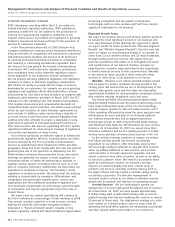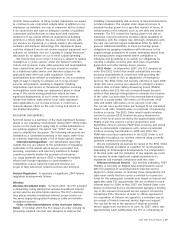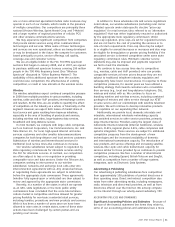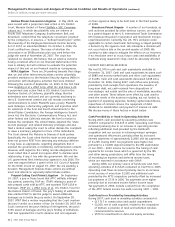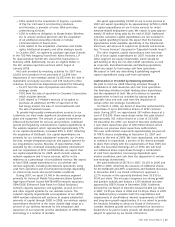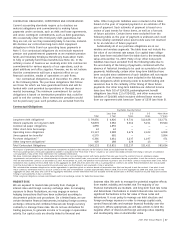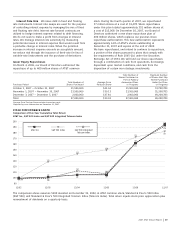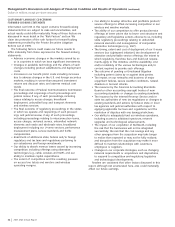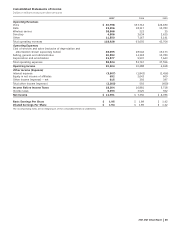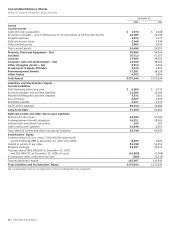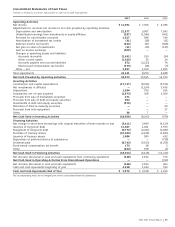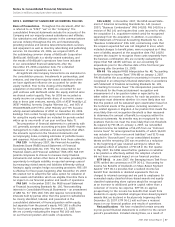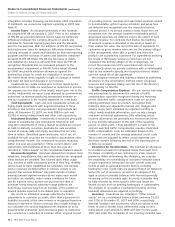AT&T Wireless 2007 Annual Report Download - page 50
Download and view the complete annual report
Please find page 50 of the 2007 AT&T Wireless annual report below. You can navigate through the pages in the report by either clicking on the pages listed below, or by using the keyword search tool below to find specific information within the annual report.
Management’s Discussion and Analysis of Financial Condition and Results of Operations (continued)
Dollars in millions except per share amounts
48
| 2007 AT&T Annual Report
We enter into foreign currency contracts to minimize our
exposure to risk of adverse changes in currency exchange
rates. We are subject to foreign exchange risk for foreign
currency-denominated transactions, such as debt issued,
recognized payables and receivables and forecasted transac-
tions. At December 31, 2007, our foreign currency exposures
were principally Euros, British pound sterling, Danish krone
and Japanese yen.
QUANTITATIVE INFORMATION ABOUT MARKET RISK
In order to determine the changes in fair value of our various
financial instruments, we use certain financial modeling
techniques. We apply rate-sensitivity changes directly to our
interest rate swap transactions and forward rate sensitivity to
our foreign currency-forward contracts.
The changes in fair value, as discussed below, assume the
occurrence of certain market conditions, which could have an
adverse financial impact on AT&T and do not represent
projected gains or losses in fair value that we expect to incur.
Future impacts would be based on actual developments in
global financial markets. We do not foresee any significant
changes in the strategies used to manage interest rate risk,
foreign currency rate risk or equity price risk in the near future.
Interest Rate Sensitivity The principal amounts by
expected maturity, average interest rate and fair value of our
liabilities that are exposed to interest rate risk are described
in Notes 8 and 9. Following are our interest rate derivatives,
subject to interest rate risk as of December 31, 2007. The
interest rates illustrated in the interest rate swaps section
of the table below refer to the average expected rates we
would receive and the average expected rates we would
pay based on the contracts. The notional amount is the
principal amount of the debt subject to the interest rate
swap contracts. The net fair value asset (liability) represents
the amount we would receive or pay if we had exited the
contracts as of December 31, 2007.
Maturity
After Fair Value
2008 2009 2010 2011 2012 2012 Total 12/31/07
Interest Rate Derivatives
Interest Rate Swaps:
Receive Fixed/Pay Variable Notional Amount — — — $1,250 $2,000 — $3,250 $88
Variable Rate Payable1 4.6% 4.4% 5.1% 5.4% 5.3% —
Weighted-Average Fixed Rate Receivable 6.0% 6.0% 6.0% 6.0% 5.9% —
1Interest payable based on current and implied forward rates for Three or Six Month LIBOR plus a spread ranging between approximately 64 and 170 basis points.
We had fair value interest rate swaps with a notional value
of $3,250 at December 31, 2007, and $5,050 at
December 31, 2006, with a net carrying and fair value asset
of $88 and liability of $80, respectively. The net fair value
liability at December 31, 2006, was comprised of a liability
of $86 and an asset of $6. Included in the fair value interest
rate swap notional amount for 2006 were interest rate swaps
with a notional value of $1,800, which were acquired as a
result of our acquisition of BellSouth on December 29, 2006.
These swaps were unwound in January 2007.
Foreign Exchange Forward Contracts The fair value of
foreign exchange contracts is subject to changes in foreign
currency exchange rates. For the purpose of assessing specific
risks, we use a sensitivity analysis to determine the effects
that market risk exposures may have on the fair value of our
financial instruments and results of operations. To perform
the sensitivity analysis, we assess the risk of loss in fair
values from the effect of a hypothetical 10% change in the
value of foreign currencies (negative change in the value
of the U.S. dollar), assuming no change in interest rates.
See Note 9 to the consolidated financial statements for
additional information relating to notional amounts and
fair values of financial instruments.
For foreign exchange forward contracts outstanding at
December 31, 2007, assuming a hypothetical 10% depreciation
of the U.S. dollar against foreign currencies from the
prevailing foreign currency exchange rates, the fair value of
the foreign exchange forward contracts (net liability) would
have decreased approximately $29. Because our foreign
exchange contracts are entered into for hedging purposes,
we believe that these losses would be largely offset by
gains on the underlying transactions.
The risk of loss in fair values of all other financial instru-
ments resulting from a hypothetical 10% change in market
prices was not significant as of December 31, 2007.
QUALITATIVE INFORMATION ABOUT MARKET RISK
Foreign Exchange Risk From time to time, we make
investments in businesses in foreign countries, are paid
dividends and receive proceeds from sales or borrow funds
in foreign currency. Before making an investment, or in
anticipation of a foreign currency receipt, we often will enter
into forward foreign exchange contracts. The contracts are
used to provide currency at a fixed rate. Our policy is to
measure the risk of adverse currency fluctuations by
calculating the potential dollar losses resulting from
changes in exchange rates that have a reasonable
probability of occurring. We cover the exposure that
results from changes that exceed acceptable amounts.
We do not speculate in foreign exchange markets.


